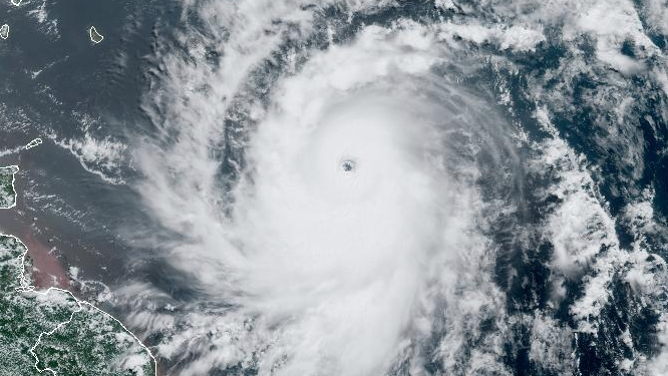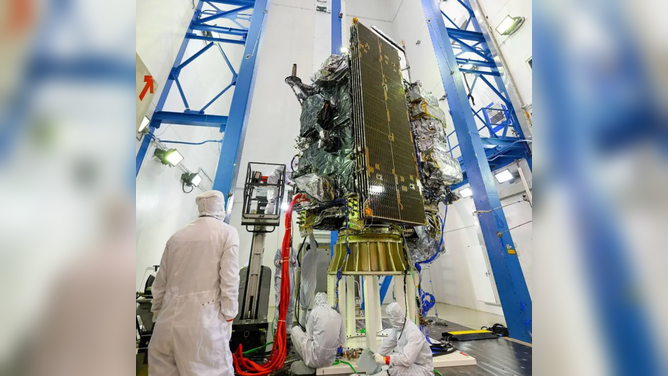What’s next for NOAA’s weather satellites now that final GOES has been placed in orbit?
A few years before the final GOES-R series launch, NOAA began planning for the future of weather satellites. Its next fleet will be called GeoXO and have new instruments and improved technology to help forecasters.
3-2-1-Take off and the GOES weather satellite starts it's journey to a new home in space
FOX Weather's Brandy Campbell was live at the launch of the GOES-U weather satellite in Florida. This is the final GOES satellite that will complete NOAA's constellation of remote weather monitors.
NOAA’s final GOES satellite entered its operational orbit this week, and the agency is considering the future of weather-observing satellites to accommodate a warming planet and weather extremes.
The final GOES-R series satellite, GOES-U, launched on June 25 from Kennedy Space Center on a SpaceX Falcon Heavy rocket. On July 7, NOAA said GOES-U made its final engine burn in space. After reaching more than 22,000 miles above Earth, GOES-U was renamed GOES-19.
In the coming months, GOES-19 will become GOES-East. The satellite's predecessor, watching over North and South America and the surrounding oceans, has been busy helping NOAA's National Hurricane Center track and forecast impacts from Hurricane Beryl. The storm made history by becoming the strongest Atlantic hurricane on record in June or July and the earliest Category 5 storm on record on July 1. Beryl quickly weakened after its third and final landfall in Texas.
READ: BERYL BECOMES RECORD-BREAKING CATEGORY 5 HURRICANE

A look at Hurricane Beryl on Sunday, June 30, 2024.
(NOAA)
GeoXO: The future of NOAA satellites
A few years before the final GOES-R series launch, NOAA began planning for the future of weather satellites. Its next fleet will be called GeoXO, which stands for Geostationary Extended Observations.
NOAA GOES Chief Scientist Dan Lindsey told FOX Weather ahead of the GOES-U launch that NOAA needed to accommodate for the changing climate in the decades to come.
"One of the things we had to do in planning is sort of predict what type of observations will we need in say 2040 or 2050?" Lindsey said. "The Earth will be different, it will be warmer."
NOAA made small changes to each GOES-R series satellite, but GeoXO will allow the agency to take advantage of big technological leaps. The GOES satellites already provide high-resolution imagery with the advanced baseline imager (ABI), the spacecraft’s primary instrument.
"The GeoXO imager will be significantly improved over the ABI, better resolution, and better, more spectral channels, and it gives you sort of a different picture of the atmosphere," Lindsey said. "The lightning mapper will be improved to some degree, and then we're also adding new instruments too. So yeah, it's really taking a step forward in the technical, technological department for GeoXO."
NASA, which oversees the development and launch of the satellites, selected Lockheed Martin to develop the three GeoXO spacecraft. The company was also responsible for the GOES-R series.
GEO Weather Program Director with Lockheed Martin Jagdeep Shergill told FOX Weather that Lockheed is already planning for the GeoXO spacecraft.
"It’s been a long road," Shergill said. "The GOES R series has been a 15-year program that we have been executing, and the GOES-U build has been the last 3 to 4 years."

NOAA’s GOES-U satellite construction at Lockheed Martin Space’s Littleton, Colorado.
(NASA)
The GeoXO satellites will begin launching and operating in the early 2030s with the second satellite launch in 2035.
The third GeoXO satellite will include two new instruments: a sounder to gather information about atmospheric moisture, wind and temperature and an atmospheric composition instrument to measure air pollutants for air quality monitoring.
The legacy of GOES
NOAA’s GOES satellites have been monitoring the weather and climate on Earth for nearly 50 years.
NOAA plans to operate GeoXO satellites through the 2050s and possibly longer if the spacecraft remain operational past their planned lifespan like the GOES-R satellites.
GOES satellites are designed with an operational lifespan of about 10 years, but many have exceeded their lifespans.
"The longest serving GOES, actually, lasted for 40 years," said Charles Webb, NASA's Joint Agency Satellite Division deputy director. "Admittedly, not doing all of the things that it had been designed to do, but serving as a communication relay, essentially, for scientists that were in Antarctica."
NOAA GOES satellite program enhances ability to track weather
A look at how the GOES satellite program enhances forecasters abilities to track weather.
Lindsey recalled another time in GOES history when Japan was having problems with one of its weather satellite instruments, and NOAA loaned them one of the GOES satellites until the issue was repaired.
Meanwhile, GOES-13 and GOES-15 were transferred to the U.S. Space Force for operations over the Indian Ocean.
"It's so difficult and expensive to build and launch these satellites that once they're up there in orbit, as long as they're still sending back data, we can definitely find uses for them," Lindsey said.

